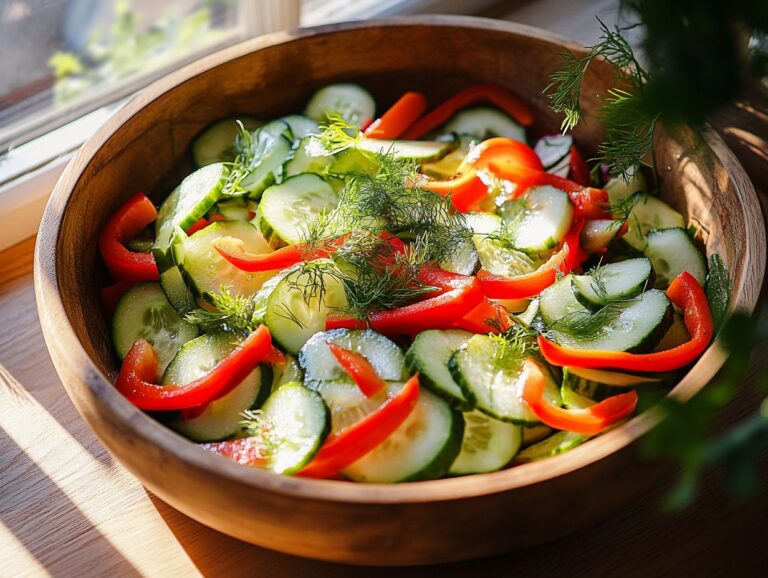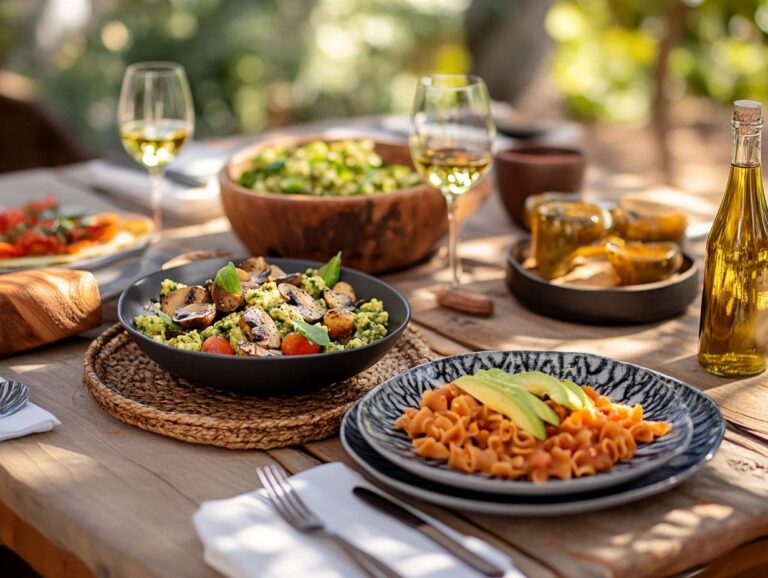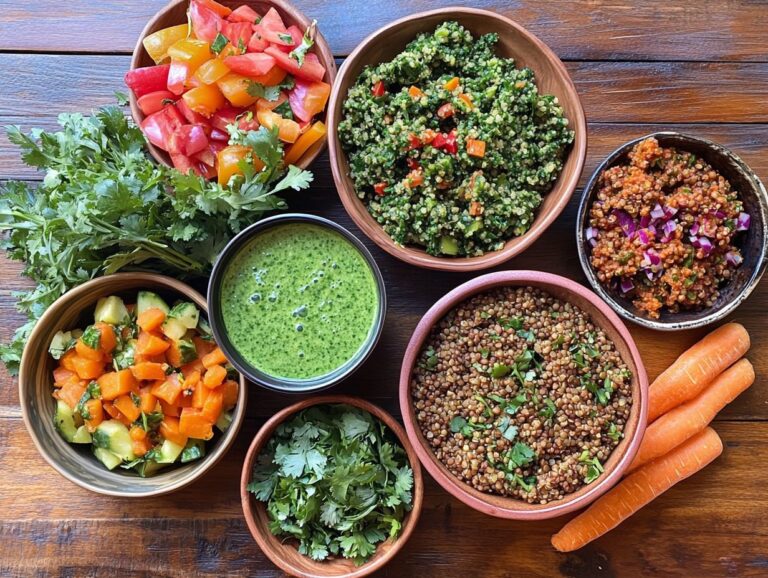Vegan Cajun food captures the bold and flavorful essence of Southern cuisine while embracing a plant-based lifestyle, demonstrating that you don’t have to compromise on taste for compassion. This cuisine highlights essential ingredients and key spices that contribute to its vibrancy, featuring traditional dishes reimagined for vegans, such as gumbo and jambalaya. Explore creative twists on classic favorites and discover tips for hosting a memorable Vegan Cajun feast that will delight both friends and family.
What is Vegan Cajun Food?
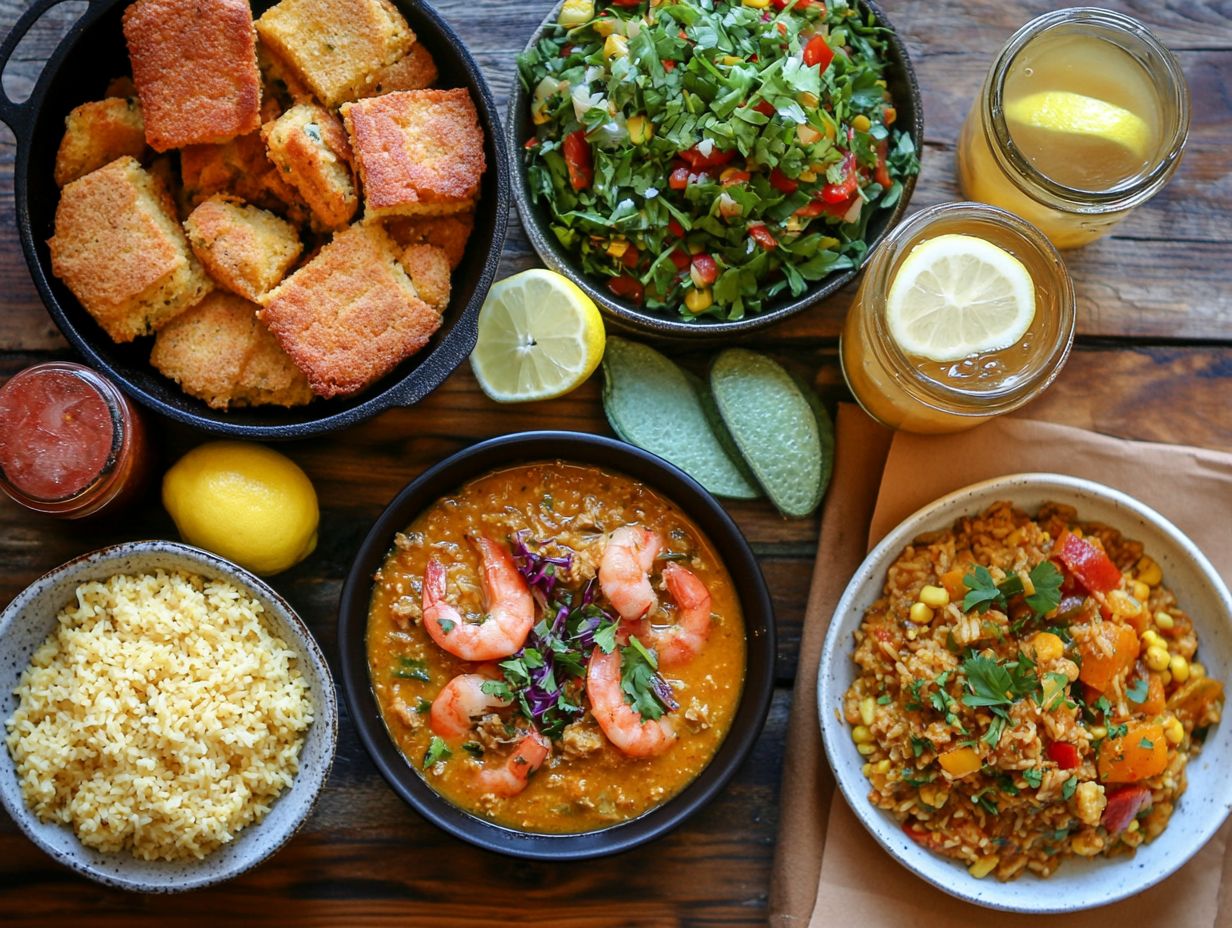
Vegan Cajun food is a vibrant culinary style that combines the rich and bold flavors of Southern cooking with the principles of plant-based cuisine. This delightful array of dishes caters to both health-conscious individuals and those in search of comfort food, making it a perfect choice for family-friendly meals and entertaining.
This unique fusion preserves the essence of traditional Cajun recipes while replacing animal-based ingredients with nutritious vegan alternatives, resulting in flavorful and savory meals that reflect the heart of Cajun culture, perfect for dinner parties and potlucks.
From spicy gumbo to hearty jambalaya, Vegan Cajun food offers an inviting way to experience the warmth of Southern hospitality through a plant-based perspective.
Essential Ingredients for Vegan Cajun Cooking
The ingredients of Vegan Cajun cooking are essential components that determine the trademark flavors and textures of the cuisine. This style of cooking relies on a combination of spices, herbs, and plant-based foods to achieve its distinctive profile, highlighting the importance of fresh produce and local ingredients.
Cajun cooking is characterized by its robust seasoning, typically featuring Cajun seasoning, garlic, onion, bell peppers, and a variety of fresh herbs, which contribute depth and complexity to each dish.
Selecting the right ingredients, particularly seasonal ones, not only enhances the taste but also boosts the nutritional value of the food, ensuring that every dish is pleasing to the palate as well as beneficial for the body. Utilizing ethical eating practices and gluten-free options can further enhance the meal’s appeal.
Key Spices and Substitutes
Vegan Cajun food depends on key spices to create the rich, bold flavors for which this cuisine is renowned, while alternative versions of traditional recipes make them accessible and enjoyable for plant-based eaters.
The foundation of this flavor profile lies in the iconic combination of cayenne pepper, paprika, and black pepper, which together deliver both heat and depth in every dish. For a smoky flavor, smoked paprika can be used instead of regular paprika. Additionally, bay leaves and thyme contribute the herbal notes that are characteristic of traditional Cajun cooking.
Vegan adaptations of Cajun recipes utilize vegetable broth in place of chicken broth, thereby preserving the traditional flavor while adding richness to the dish. Crunchy vegetables such as bell peppers and celery can be included to replicate the ‘holy trinity’ of Cajun cuisine, ensuring that flavor enthusiasts and health-conscious diners alike can savor the delightful tastes of this vibrant cuisine. Ingredients like tofu and black-eyed peas can also be excellent additions for extra protein.
Traditional Cajun Dishes Made Vegan
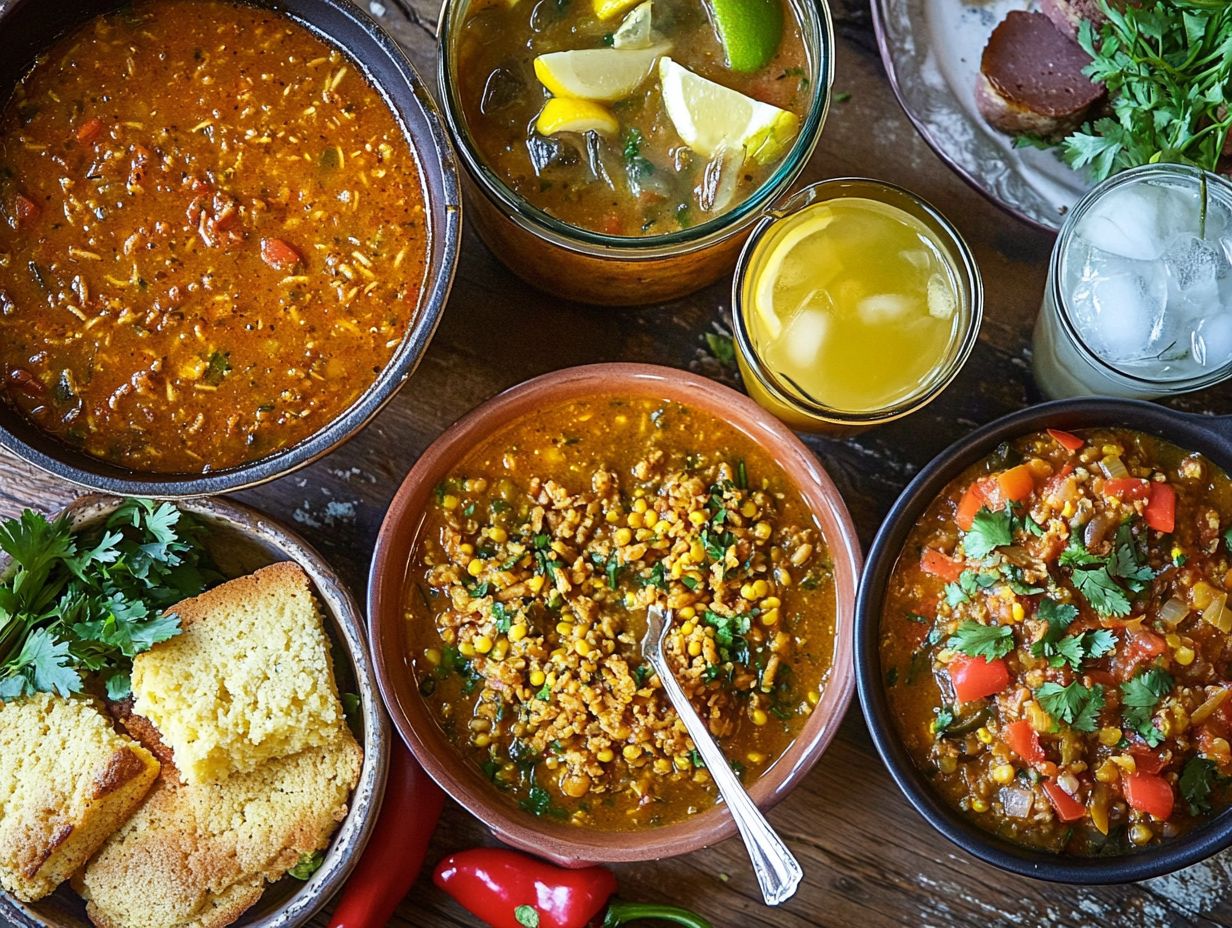
Traditional Cajun dishes can be transformed into vegan versions, allowing those seeking plant-based options to enjoy familiar flavors.
Dishes featuring complex spices, such as gumbo, jambalaya with hearty textures, and red beans and rice that evoke comforting childhood memories, can all be adapted to incorporate lentils, chickpeas, or vegan andouille sausage in place of traditional meat and sausage. For an added layer of flavor, you can use vegan butter in the preparation.
This approach maintains the authentic taste while introducing healthier alternatives, ensuring that everyone can partake in the celebrations.
Vegan Gumbo (with Creole twist)
Vegan gumbo is a classic Cajun dish that incorporates a wide array of spices, seasonal vegetables, and plant-based proteins to create a warm and hearty meal. Traditionally, gumbo is prepared with a flavorful broth and a variety of ingredients, including okra, bell peppers, and vegan sausage, which contribute to its distinctive texture and taste. Other possible additions are black-eyed peas and tofu for more variety and protein.
By incorporating seasonal herbs and spices along with a unique twist, this vegan version of gumbo preserves the essence of the original dish while introducing new flavors that can be enjoyed by many.
To create an exceptional vegan gumbo, the key ingredient is a well-balanced roux made from cooked flour and oil. When prepared correctly, the roux transforms into a deep, nutty base with a beautiful brown hue that adds complexity to the dish.
The choice of vegetables is also crucial; for example, okra not only thickens the gumbo but also imparts an earthy flavor, while bell peppers provide a sweet crunch that contrasts beautifully with the spiced seasonings. Incorporating roasted vegetables like zucchini can add additional layers of flavor.
Essential elements of Southern flavor, such as smoked paprika and thyme, enrich each bite, making it a comforting dish. Various cooking techniques, such as caramelizing the vegetables until golden, enhance their natural sweetness, while simmering allows the flavors to meld together, resulting in a delicious pot of gumbo. For a gourmet touch, adding cashews or coconut milk can provide a creamy texture.
To cater to different tastes, you can incorporate options like lentils for added protein or a splash of hot sauce for extra heat.
Red Beans and Rice
Red beans and rice is a quintessential comfort food that captures the essence of Cajun culture. Creating a vegan version allows everyone to enjoy this beloved dish without sacrificing its rich flavors. This hearty meal typically consists of red kidney beans seasoned to perfection with spices and served over fluffy rice, providing a satisfying balance of protein and carbohydrates.
By using plant-based alternatives while maintaining the core elements of the recipe, home cooks can prepare a nutritious and delicious meal that celebrates Cajun culinary traditions. The use of spices and herbs such as filé powder, thyme, and smoked paprika can enhance the authentic taste.
To prepare this dish, start by soaking the red kidney beans overnight or using the quick-soak method to ensure even cooking. Next, sauté aromatic vegetables such as onions, bell peppers, and celery in a generous splash of olive oil to infuse the dish with flavor from the very beginning. Add the soaked beans along with vegetable broth, garlic, and spices like paprika, cayenne, and thyme to enhance the authentic taste.
As the beans simmer gently, serve them over a bed of fluffy rice for a filling and colorful presentation.
For those interested in meal prepping, this dish is ideal, as it can be made in large batches and stored in the fridge or freezer for easy reheating. The variations are endless; for instance, you might introduce seasonal vegetables like zucchini or spinach, or even experiment with different spice blends to customize the heat level and flavor profile.
Jambalaya
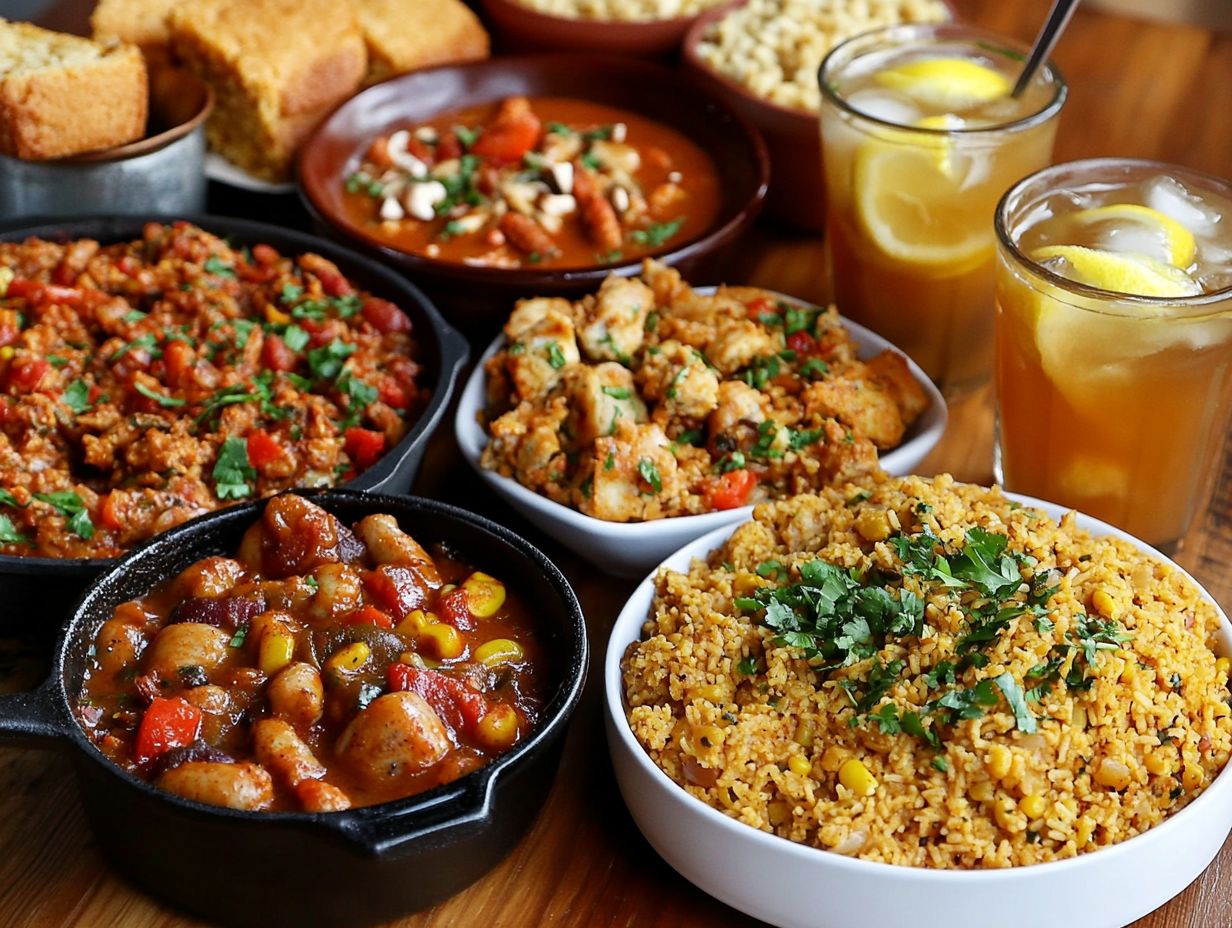
Vegan jambalaya is a flavorful one-pot dish that combines rice with a variety of vegetables and proteins, all seasoned with a bold mix of spices typical of Cajun cuisine. Whether served as a main course or a side dish, this recipe can incorporate a wide range of seasonal vegetables, along with plant-based proteins such as vegan sausage and tempeh. The spicy, savory flavors characteristic of Southern hospitality make it a comforting and hearty meal. Nutritional yeast can also be added for a cheesy flavor.
The instructions for preparing vegan jambalaya begin with the crucial step of sautéing onions, bell peppers, and celery to create a flavorful base. Next, garlic and spices like paprika, cayenne, and thyme are added to the aromatics to provide the distinctive kick associated with jambalaya.
The mixture is then allowed to simmer with vegetable broth and diced tomatoes, enabling the flavors to meld while the rice absorbs the delicious juiciness of the vegetables and spices. For added texture and protein, you can include beans or chickpeas. Adding a splash of hot sauce can also give the dish an extra kick.
Additionally, unique ingredients such as artichoke hearts or roasted corn can be incorporated to enhance the dish’s complexity. Adding vegan substitutes like gluten-free pasta or quinoa can provide more dietary options.
Creative Vegan Cajun Twists on Classic Dishes
Creative and vegan twists on classic Cajun dishes can introduce new flavors and innovations within the Cajun cooking style, encouraging cooks to experiment with different flavor profiles while remaining connected to their culinary heritage. By incorporating meal prep strategies and cooking techniques like grilling or using a skillet, these dishes can be tailored to fit any dietary preference.
These reimagined dishes allow plant-based enthusiasts to explore exciting new combinations. Examples include:
- Vegan Étouffée (with a touch of coconut milk)
- Spicy tofu po’ boys served with collard greens
- Cajun-spiced lentils (great for meal prep)
- Cajun-spiced chickpea burgers
- Cajun vegetable jambalaya
- Cajun gazpacho soup
- Cajun-style tacos (perfect for potlucks)
- Cajun stuffed bell peppers (with rice and beans)
Each of these dishes showcases how traditional Cajun flavors can be infused into classic recipes.
Vegan Etouffee
Vegan étouffée is a rich and flavorful dish that captures the essence of Cajun comfort food while providing a satisfying plant-based alternative. Traditionally prepared with a roux and served over rice, this dish highlights the depth of Cajun spices and herbs, resulting in a creamy and indulgent experience. Homemade étouffée can be served with sides like vegan cornbread or sautéed collard greens for a full meal.
By replacing animal-based proteins with vegetables such as cauliflower or lentils, cooks can preserve the heartiness of étouffée while ensuring it remains both flavorful and nutritious. This dish not only celebrates plant-based ingredients but also showcases culinary creativity, inviting everyone to explore the vibrant flavors of Louisiana cooking.
The foundation of vegan étouffée lies in its roux, which adds depth and a luxurious texture to the dish. Perfecting the roux requires patiently cooking flour with oil until it reaches a rich chestnut color, imparting a nutty flavor that beautifully complements the spices. Using vegan butter in the roux can enhance its richness and flavor infusion.
Once the roux is ready, onions, bell peppers, and celery are sautéed to form the holy trinity of Cajun cuisine, followed by the addition of garlic, tomatoes, and vegetable broth, which together create a symphony of flavors. Balancing these ingredients with spices like cayenne and smoked paprika ensures that each bite bursts with delicious character, making this comforting dish a worthy centerpiece for gatherings or a simple family dinner. To enhance the Creole and Southern authenticity, consider adding okra and filé powder for a true gumbo experience, served alongside traditional cornbread.
Spicy Tofu Po’ Boys
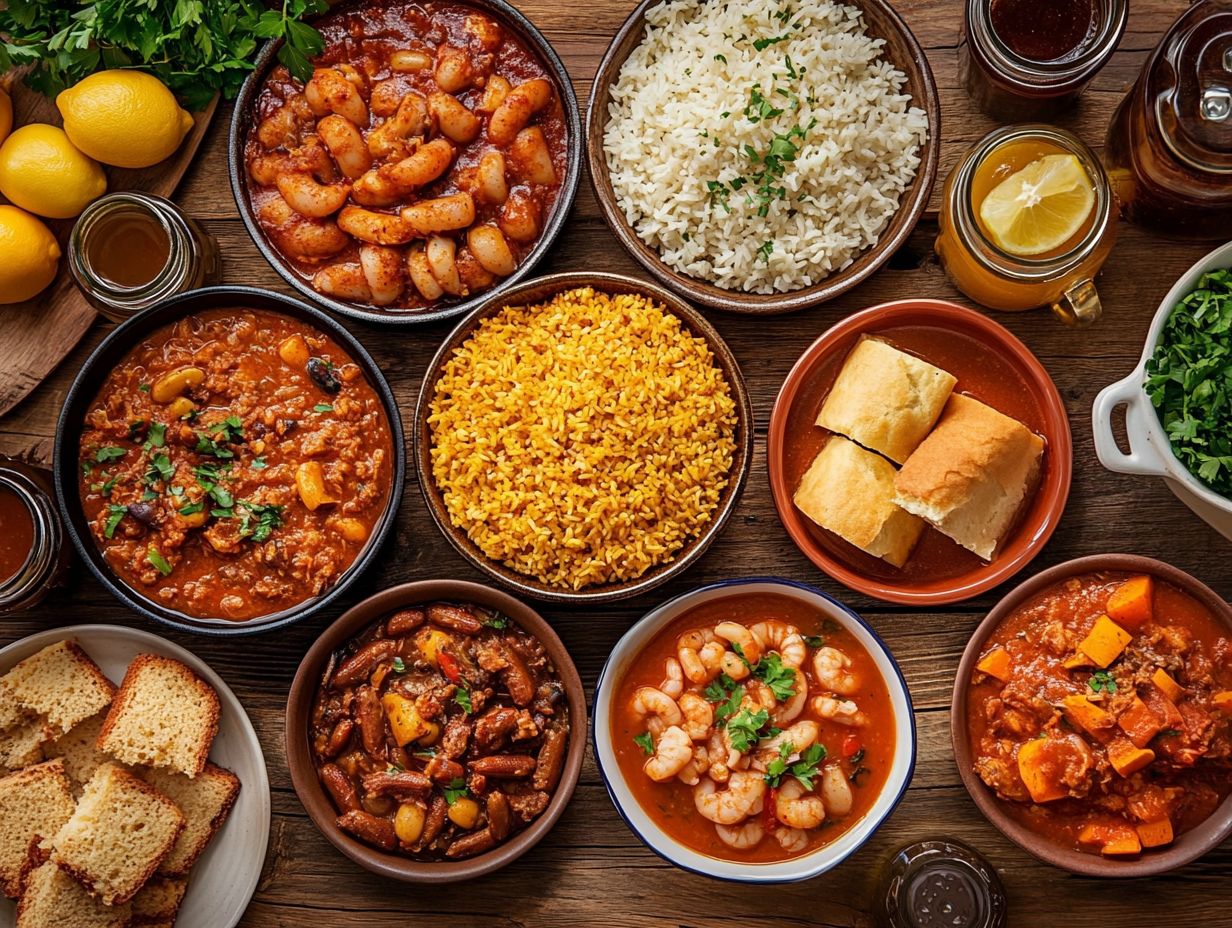
Spicy tofu po’ boys are a delectable plant-based twist on the classic Cajun sandwich, featuring crispy, flavorful tofu and a variety of toppings that create an unforgettable culinary experience. A well-crafted po’ boy includes crusty bread generously filled with protein and topped with fresh vegetables and spicy sauces, such as hot sauce or a vegan remoulade, making it one of the best party foods that caters to diverse palates.
By marinating the tofu in Cajun spices and pairing it with a zesty vegan remoulade, these sandwiches become both satisfying and a celebration of Southern flavors.
To prepare the tofu, it is pressed to remove excess moisture, allowing it to better absorb the marinade. An effective marination method involves soaking the tofu in a mixture of soy sauce, garlic powder, paprika, and cayenne pepper for at least 30 minutes, imparting a spicy richness to the protein. After marination, the slices are pan-fried in a skillet until they develop a golden-brown crust, providing a delightful contrast to the soft bread. Consider serving with a side of roasted vegetables or collard greens to complete this Southern inspired meal.
The po’ boys can be customized with toppings like lettuce, tomatoes, pickles, and avocado to suit individual tastes. This dish’s versatility makes it perfect for social gatherings, appealing to both vegans and meat-eaters alike, and demonstrating that delicious plant-based meals can be the centerpiece of any event.
Tips for Hosting a Vegan Cajun Feast
To host a successful vegan Cajun feast, it is essential to carefully plan a menu that offers a diverse array of dishes to accommodate guests with varying preferences and tastes, all while ensuring that the food can be cooked and served at home. Incorporating recipes for jambalaya, andouille-inspired seitan sausages, and flavorful BBQ tofu can showcase the richness of Southern cuisine.
The menu should feature both traditional vegan Cajun recipes and creative adaptations, allowing hosts to showcase their culinary skills or highlight the talents of their favorite local restaurants. This approach also embodies the spirit of Southern hospitality, which is an important aspect of Cajun culture. Consider using local ingredients and fresh produce to enhance the flavors and support ethical eating.
Menu Planning and Preparing for Guests
Effective menu planning is essential for hosting a memorable vegan Cajun feast, as it allows hosts to tailor their selections to satisfy a variety of palates while ensuring a cohesive dining experience. Considering ingredient availability, seasonal produce, and cooking techniques can enhance the meal preparation process, ensuring that each dish retains its signature flavors.
By thoughtfully curating the menu, hosts can create a delightful combination of flavors and textures that reflect the warmth and hospitality of Cajun culture.
When planning the menu, it is beneficial to incorporate a mix of spicy, savory, and comforting dishes, ensuring that there is something to suit every guest’s preference. Preparation can begin several days in advance, such as chopping vegetables and marinating proteins, which helps save time on the day of the event. Utilize flavorful vegan butter and nutritional yeast to add depth to your dishes, enhancing the overall taste experience.
Utilizing techniques like sautéing, grilling, or baking can elevate the dishes, allowing vibrant flavors to shine through while minimizing kitchen chaos. Experiment with cooking methods such as using coconut milk for creamy textures or cashews for rich sauces to diversify the flavor profiles. To create an inviting atmosphere, consider adding decorative touches such as themed table settings and soft lighting, which can enhance the overall dining experience and make guests feel welcome and appreciated.
